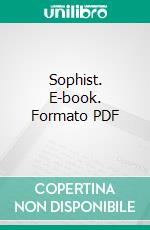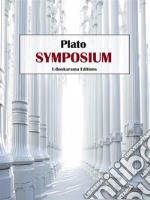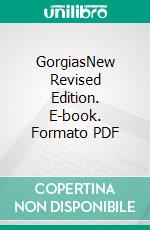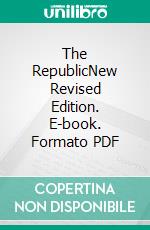Sophist. E-book. Formato PDF - 9788834195468
di Plato
edito da IONLINESHOPPING.COM , 2019
Formato: PDF - Protezione: nessuna
The Sophist is a Platonic dialogue from the philosopher's late period, most likely written in 360 BC. Its main theme is to identify what a sophist is and how a sophist differs from a philosopher and statesman. Because each seems distinguished by a particular form of knowledge, the dialogue continues some of the lines of inquiry pursued in the epistemological dialogue, Theaetetus, which is said to have taken place the day before. Because the Sophist treats these matters, it is often taken to shed light on Plato's Theory of Forms and is compared with the Parmenides, which criticized what is often taken to be the theory of forms.
Like its sequel, the Statesman, the dialogue is unusual in that Socrates is present but plays only a minor role. Instead, the Eleatic Stranger takes the lead in the discussion. The fact that Socrates is present but silent makes it difficult to attribute the views put forward by the Eleatic Stranger to Plato, beyond the difficulty inherent in taking any character to be an author's "mouthpiece."
This dialogue takes place a day after Plato's Theaetetus in an unspecified gymnasium in Athens. The participants are Socrates, who plays a minor role, the elder mathematician Theodorus, the young mathematician Theaetetus, and a visitor from Elea, the hometown of Parmenides and Zeno, who is often referred to in English translations as the Eleatic Stranger or the Eleatic Visitor. Other young mathematicians are also silently present. The dialogue begins when Socrates arrives and asks the Eleatic Stranger whether in his homeland the sophist, statesperson, and philosopher are considered to be one kind or three. The Eleatic Stranger responds that they are three, and then sets about to give an account of the sophist through dialectical exchange with Theaetetus.
The Eleatic Stranger pursues a different method of definition than features in Plato's other dialogues by the use of a model, comparison of the model with the target kind, collection, and division (diairesis), of the collected kinds. At first he starts with the use of a mundane model (a fisherman), which shares some qualities in common with the target kind (the sophist). This common quality is the certain expertise (techne) in one subject. Then through the method of collection of different kinds (farming, caring for mortal bodies, for things that are put together or fabricated and imitation), he tries to bring them together into one kind, which he calls productive art. The same is true with the collection of learning, recognition, commerce, combat and hunting, which can be grouped into the kind of acquisitive art.
Since Plato wrote the Statesman after the Sophist, while he never wrote the dialogue Philosopher, many scholars argue that Plato challenges the audience to search for the definition of the philosopher themselves, by applying the method of inquiry and definition shown in those two dialogues. However, this does not mean that one can simply extend the method in a mechanical way to the investigation of the philosopher, but he only shows us how one can proceed in such philosophical enquiries.
Like its sequel, the Statesman, the dialogue is unusual in that Socrates is present but plays only a minor role. Instead, the Eleatic Stranger takes the lead in the discussion. The fact that Socrates is present but silent makes it difficult to attribute the views put forward by the Eleatic Stranger to Plato, beyond the difficulty inherent in taking any character to be an author's "mouthpiece."
This dialogue takes place a day after Plato's Theaetetus in an unspecified gymnasium in Athens. The participants are Socrates, who plays a minor role, the elder mathematician Theodorus, the young mathematician Theaetetus, and a visitor from Elea, the hometown of Parmenides and Zeno, who is often referred to in English translations as the Eleatic Stranger or the Eleatic Visitor. Other young mathematicians are also silently present. The dialogue begins when Socrates arrives and asks the Eleatic Stranger whether in his homeland the sophist, statesperson, and philosopher are considered to be one kind or three. The Eleatic Stranger responds that they are three, and then sets about to give an account of the sophist through dialectical exchange with Theaetetus.
The Eleatic Stranger pursues a different method of definition than features in Plato's other dialogues by the use of a model, comparison of the model with the target kind, collection, and division (diairesis), of the collected kinds. At first he starts with the use of a mundane model (a fisherman), which shares some qualities in common with the target kind (the sophist). This common quality is the certain expertise (techne) in one subject. Then through the method of collection of different kinds (farming, caring for mortal bodies, for things that are put together or fabricated and imitation), he tries to bring them together into one kind, which he calls productive art. The same is true with the collection of learning, recognition, commerce, combat and hunting, which can be grouped into the kind of acquisitive art.
Since Plato wrote the Statesman after the Sophist, while he never wrote the dialogue Philosopher, many scholars argue that Plato challenges the audience to search for the definition of the philosopher themselves, by applying the method of inquiry and definition shown in those two dialogues. However, this does not mean that one can simply extend the method in a mechanical way to the investigation of the philosopher, but he only shows us how one can proceed in such philosophical enquiries.
Ean
9788834195468
Titolo
Sophist. E-book. Formato PDF
Autore
Editore
Data Pubblicazione
2019
Formato
PDF
Protezione
nessuna
Punti Accumulabili








